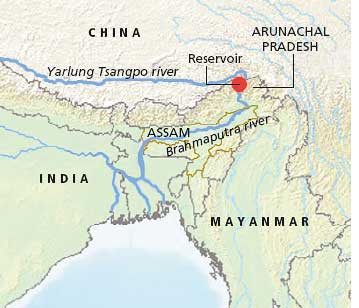
In News
The Prime Minister of India will virtually launch the Mahabahu-Brahmaputra Programme and lay the foundation stone of Dhubri Phulbari Bridge and Majuli Bridge in Assam.
Mahabahu-Brahmaputra Programme
- Aims: To provide seamless connectivity to the Eastern parts of India.
- It includes various development activities for the people living around River Brahmaputra and River Barak.
- Inauguration of the Ro-Pax Vessel Operations.
- Ro-Pax is an acronym for roll-on/roll-off a passenger. It is a ro-ro vessel built for freight vehicle transport with passenger accommodation.
- Benefit
- These will help in reducing the travel time by providing connectivity between banks and thus reducing the distance.
- Various Ro-Pax vessels connecting different places will result in a substantial impact on the logistics of small-scale industries of the region and also in a huge savings of time and money.
- Inland Water Transport (IWT) Terminal
- A permanent IWT Terminal will also be built at Jogighopa which will connect with the Multi-Modal Logistics Park also coming up at Jogighopa.
- Benefit
- It will help in reducing the traffic on the Siliguri Corridor towards Kolkata and Haldia.
- It will also facilitate the uninterrupted movement of cargo (even during flood season) to Meghalaya, Tripura, Bhutan and Bangladesh.
- Tourist Jetties on Brahmaputra
- Tourist jetties at Neamati, Biswanath Ghat, Pandu and Jogighopa will be constructed with the financial assistance of Rs. 9.41 crores from the Ministry of Tourism.
- A jetty is a long, narrow structure that protects a coastline from the currents and tides. Jetties are usually made of wood, earth, stone, or concrete. They stretch from the shore into the water.
- Jetties can also be used to connect the land with deep water farther away from shore for the purposes of docking ships and unloading cargo. This type of jetty is called a pier.
- Benefit: These will promote river cruise tourism, generate local employment and also generate growth for local business.
- Tourist jetties at Neamati, Biswanath Ghat, Pandu and Jogighopa will be constructed with the financial assistance of Rs. 9.41 crores from the Ministry of Tourism.
- Digital Solutions for Ease-of-Doing-Business
- The Cargo Data (Car-D) portal will collate cargo and cruise data on a real-time basis.
- Portal for Asset and Navigation Information (PANI) will act as a one-stop solution for providing information about river navigation and infrastructure.
Dhubri Phulbari Bridge
- It will be a four-lane bridge over the Brahmaputra between Dhubri (on North Bank) and Phulbari (on South Bank).
- It will be located on NH-127B, originating from Srirampur on NH-27 (East-West Corridor), and terminating at Nongstoin on NH-106 in the State of Meghalaya.
- The 19 km long bridge will be made with a cost of approximately Rs. 4997 crore.
- Benefit
- It will meet the long-standing demand for ferry services to travel between the two banks of the river.
- It will reduce the earlier distance of 205 km to 19 km.
Majuli Bridge
- It will be a two-lane bridge on the Brahmaputra between Majuli (North Bank) and Jorhat (South Bank).
- It will be located on NH-715K.
- Benefit
- This bridge has been a long demand of the people of Majuli who have been dependent on the ferry services to connect with the mainland of Assam.
- Now, they will be able to use the bridge and enjoy access to the city.
|
Brahmaputra
(Image Courtesy: DTE) |
Source: PIB
Previous article
Google’s Payment Deal with Australian Media Firm
Next article
Facts in News
